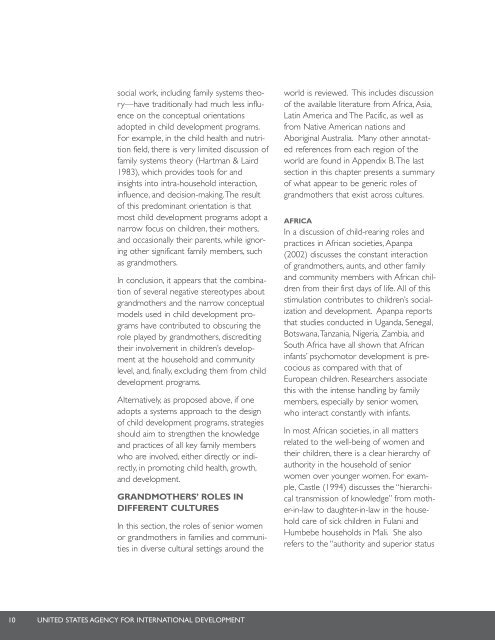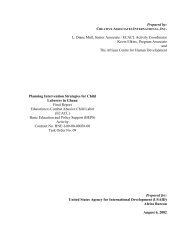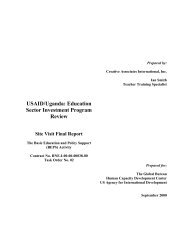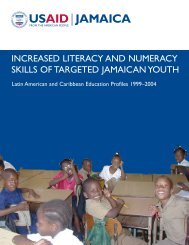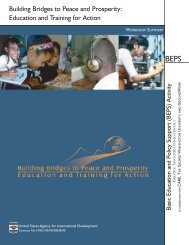social work, including family systems theory—havetraditionally had much less influenceon the conceptual orientationsadopted in child development programs.For example, in the child health <strong>and</strong> nutritionfield, there is very limited discussion offamily systems theory (Hartman & Laird1983), which provides tools for <strong>and</strong>insights into intra-household interaction,influence, <strong>and</strong> decision-making.The resultof this predominant orientation is thatmost child development programs adopt anarrow focus on children, their mothers,<strong>and</strong> occasionally their parents, while ignoringother significant family members, suchas gr<strong>and</strong>mothers.In conclusion, it appears that the combinationof several negative stereotypes aboutgr<strong>and</strong>mothers <strong>and</strong> the narrow conceptualmodels used in child development programshave contributed to obscuring therole played by gr<strong>and</strong>mothers, discreditingtheir involvement in children’s developmentat the household <strong>and</strong> communitylevel, <strong>and</strong>, finally, excluding them from childdevelopment programs.Alternatively, as proposed above, if oneadopts a systems approach to the designof child development programs, strategiesshould aim to strengthen the knowledge<strong>and</strong> practices of all key family memberswho are involved, either directly or indirectly,in promoting child health, growth,<strong>and</strong> development.GRANDMOTHERS’ ROLES INDIFFERENT CULTURESIn this section, the roles of senior womenor gr<strong>and</strong>mothers in families <strong>and</strong> communitiesin diverse cultural settings around theworld is reviewed. This includes discussionof the available literature from Africa, Asia,Latin America <strong>and</strong> The Pacific, as well asfrom Native American nations <strong>and</strong>Aboriginal Australia. Many other annotatedreferences from each region of theworld are found in Appendix B.The lastsection in this chapter presents a summaryof what appear to be generic roles ofgr<strong>and</strong>mothers that exist across cultures.AFRICAIn a discussion of child-rearing roles <strong>and</strong>practices in African societies, Apanpa(2002) discusses the constant interactionof gr<strong>and</strong>mothers, aunts, <strong>and</strong> other family<strong>and</strong> community members with African childrenfrom their first days of life. All of thisstimulation contributes to children’s socialization<strong>and</strong> development. Apanpa reportsthat studies conducted in Ug<strong>and</strong>a, Senegal,Botswana,Tanzania, Nigeria, Zambia, <strong>and</strong>South Africa have all shown that Africaninfants’ psychomotor development is precociousas compared with that ofEuropean children. Researchers associatethis with the intense h<strong>and</strong>ling by familymembers, especially by senior women,who interact constantly with infants.In most African societies, in all mattersrelated to the well-being of women <strong>and</strong>their children, there is a clear hierarchy ofauthority in the household of seniorwomen over younger women. For example,Castle (1994) discusses the “hierarchicaltransmission of knowledge” from mother-in-lawto daughter-in-law in the householdcare of sick children in Fulani <strong>and</strong>Humbebe households in Mali. She alsorefers to the “authority <strong>and</strong> superior status10 UNITED STATES AGENCY FOR INTERNATIONAL DEVELOPMENT
of senior female household members”over younger females in the household(1994, 330). These same patterns arefound in numerous ethnic groups acrossAfrica.ASIAIn Chinese culture, a traditional <strong>and</strong> centralfunction of older women is to care forchildren in the family. Studying Chinesefamily systems in both Singapore <strong>and</strong>Taiwan, Jernigan <strong>and</strong> Jernigan (1992) foundthat this task not only provides an essentialservice to families but it also contributesto older women’s sense of validation <strong>and</strong>purpose in life. According to Dr. Pang(l998), a former Vice-Minister of Health incontemporary mainl<strong>and</strong> China, gr<strong>and</strong>motherscontinue to play an important advisoryrole with their daughters <strong>and</strong> daughters-inlaw.She notes that the advisory roleplayed by gr<strong>and</strong>mothers can be explained,first, by the important Chinese culturalvalue of respect for elders, <strong>and</strong> second, bythe fact that with the “one child policy”most women giving birth are first-timemothers <strong>and</strong> need advice from moreexperienced women on various childcarematters.In line with Dr. Pang’s analysis, recentresearch in Eastern China has revealed theextensive role of paternal gr<strong>and</strong>mothers.In most cases this role involves childcarewhile their daughter-in-laws are workingoutside the home (Yajun et al 1999).<strong>Gr<strong>and</strong>mothers</strong> play a leading role in variousaspects of child development, includingnutrition, hygiene, <strong>and</strong> toilet training, as wellas informal teaching related to Chinese values<strong>and</strong> traditions. When children are sick,gr<strong>and</strong>mothers also play a role in advising<strong>and</strong> treating, often using traditional remedies.In Thail<strong>and</strong>, Professor Sakorn, of theInstitute of Nutrition at Mahidol Universityin Bangkok, a prominent nutritionist inSoutheast Asia, points out the very importantrole played by gr<strong>and</strong>mothers in contemporaryThai society (Sakorn 2003).She states that an important value in Thaiculture is respect for age <strong>and</strong> experience.In this context gr<strong>and</strong>mothers are lookedto for their advice <strong>and</strong> guidance in all mattersrelated to children’s health <strong>and</strong> wellbeing.With many women working eitheroutside the home or in another part ofthe country, the role of gr<strong>and</strong>mothers inchildcare is significant.Available evidence suggests that in CentralAsia, paternal gr<strong>and</strong>mothers play a veryinfluential role in all children’s developmentalmatters <strong>and</strong> have strong influence ontheir daughter-in-laws. In a rapid assessmentconducted recently in southernUzbekistan (Aubel et al 2003) it was concludedthat Uzbek families view the gr<strong>and</strong>mothersas knowledgeable <strong>and</strong> important“general managers” of day-to-day familylife. In matters related to the well-being ofchildren <strong>and</strong> women, both husb<strong>and</strong>s <strong>and</strong>women alike consider them to be thehousehold authorities <strong>and</strong> seek theiradvice. From the time that a child is born,the daughter-in-law is expected to followthe advice of her mother-in-law regardingthe care <strong>and</strong> education of the child.Furthermore, husb<strong>and</strong>s expect their mothersto play this role <strong>and</strong> they expect theirwives to follow the advice provided tothem. In the same region, anecdotal inforGRANDMOTHERS:THE LEARNING INSTITUTION11
- Page 1 and 2: GRANDMOTHERS:A LEARNING INSTITUTION
- Page 3: GRANDMOTHERS:A LEARNING INSTITUTION
- Page 11 and 12: EXECUTIVE SUMMARYSociety itself fai
- Page 13 and 14: Education, the Bernard Van LeerFoun
- Page 15 and 16: SEVERAL FACTORS CONTRIBUTE TO THELI
- Page 17: - Who am I? Assign children to askf
- Page 20 and 21: in educational activities on home t
- Page 22 and 23: “A grandmother’s understandingo
- Page 24 and 25: “Culture tells peoplehow to view
- Page 26 and 27: attention given to grandmothers’
- Page 30 and 31: mation from Azerbaijan (McNulty 200
- Page 32 and 33: “The status of eldersin tradition
- Page 34 and 35: “As women, thegrandmothers haveli
- Page 36 and 37: members often consult the moreexper
- Page 38 and 39: “Social capital is a community’
- Page 40 and 41: In a collaborative effort between
- Page 42 and 43: in-laws and the additional free tim
- Page 44 and 45: "Involving grandmothersin community
- Page 50 and 51: CULTURALLY-ADAPTED EDUCATIONMATERIA
- Page 52 and 53: strated the power of participatory
- Page 54 and 55: effects of the new ideas, their con
- Page 57 and 58: V. GRANDMOTHERS: A LEARNING INSTITU
- Page 59 and 60: Many health and development workers
- Page 61 and 62: VI. RECOMMENDATIONS FORBASIC EDUCAT
- Page 63 and 64: parents themselves did not go to sc
- Page 65 and 66: community ties by increasing teache
- Page 67 and 68: of millions. On the other hand, som
- Page 69: teachers, teacher abuse of children
- Page 73 and 74: APPENDIX B:ANNOTATEDREFERENCES ON T
- Page 75 and 76: acceptable for younger women to mak
- Page 77 and 78: showed that men are not directly in
- Page 79 and 80:
ecause they had more time to devote
- Page 81 and 82:
matrilineal or patrilineal areas
- Page 83 and 84:
diet, work, fetal development, sexu
- Page 85 and 86:
in the family and social networks.
- Page 87 and 88:
elated, for example, to early child
- Page 89 and 90:
REFERENCESAdams, A. M., S. Madhavan
- Page 91 and 92:
BASICS and LINKAGES. 1998. Influenc
- Page 93 and 94:
Childhood Education and Development
- Page 95 and 96:
Krishna, A. and N. Uphoff. June 199
- Page 97 and 98:
Sear, R., R. Mace, and I. A. McGreg
- Page 99 and 100:
ABOUT THE AUTHORThis review was pre


